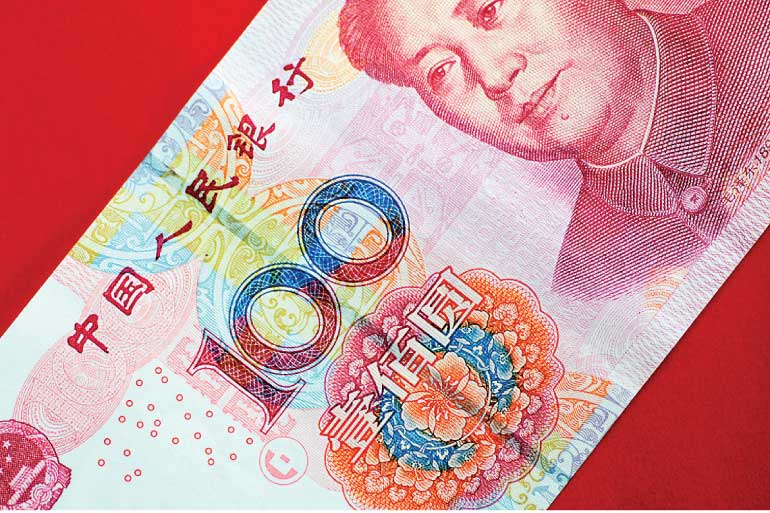Friday Mar 07, 2025
Friday Mar 07, 2025
Monday, 12 June 2017 00:01 - - {{hitsCtrl.values.hits}}
Reuters: In rapid fire moves that have stunned investors, Chinese authorities have begun tightening control over the yuan, lifting it sharply in a concerted effort to restore market confidence and forestall risks of capital outflows and slower growth, policy insiders say.

Caught off-guard last month by a ratings downgrade by Moody’s Investors Service that gave fresh momentum to bearish yuan bets, traders said Beijing has reverted to its old play book - intervening in markets to bend them to its will.
The key priority for authorities was maintaining market confidence ahead of a leadership transition later this year, policy insiders said, as growing debt risks, higher US interest rates, capital outflows and possible trade tensions with the United States threatened to knock the economy.
The policy insiders say last month’s introduction of a mysterious ‘counter-cyclical factor’ that increases the central bank’s influence over the yuan’s reference rate showed how serious authorities are about flushing out bearish bets and heading off any slide towards 7 yuan to the dollar.
The move highlighted the challenge China faces between safeguarding economic and currency stability and speeding up capital market reforms - important steps in its quest to internationalise the yuan.
“They (authorities) are clearly tightening their grip (on the yuan), which is related to politics and diplomacy,” said a policy adviser.
“From monetary authorities’ perspective, they definitely do not want to see the yuan falling past 7 - a landmark move that could affect market expectations,” the adviser said.
The People’s Bank of China (PBOC), responding to Reuters’ request for comment, denied suggestions that it’s tightening control on the yuan via the counter-cyclical factor.
“Such a statement is not true,” the PBOC said in a rare email response, and reiterated the official explanation that changes to the way the mid-point is calculated were geared to better reflect macroeconomic fundamentals and temper “irrational” market expectations.Beijing is especially sensitive to any renewed criticism of its currency policy by the United States, and a weaker yuan could play into President Donald Trump’s protectionist proclivities as Washington engages in 100 days of trade talks with China.
A second adviser said that with the Federal Reserve set to raise rates further at next policy review, authorities are worried that capital outflows could drive persistent weakness in the yuan - the last thing Chinese leaders want before the closely-watched leadership transition in the autumn.
In 2015, a botched stock market rescue attempt tarnished Beijing’s reform and broad policymaking credentials.
The yuan has gained 2.2% versus the dollar this year, including 1.3% since 24 May - when Moody’s downgraded China’s credit ratings for the first time in nearly 30 years, citing its mounting debt risks.
A Reuters poll predicted the yuan to slip toward 7.05 per dollar in 12 months.
China burned through nearly $ 320 billion of reserves last year but the yuan still fell about 6.5% against the dollar, its biggest annual drop since 1994. Latest data showed foreign exchange reserves rose to a seven-month high of $ 3.054 trillion in May, as stringent capital control measures helped staunch outflows.
Discover Kapruka, the leading online shopping platform in Sri Lanka, where you can conveniently send Gifts and Flowers to your loved ones for any event including Valentine ’s Day. Explore a wide range of popular Shopping Categories on Kapruka, including Toys, Groceries, Electronics, Birthday Cakes, Fruits, Chocolates, Flower Bouquets, Clothing, Watches, Lingerie, Gift Sets and Jewellery. Also if you’re interested in selling with Kapruka, Partner Central by Kapruka is the best solution to start with. Moreover, through Kapruka Global Shop, you can also enjoy the convenience of purchasing products from renowned platforms like Amazon and eBay and have them delivered to Sri Lanka.
Discover Kapruka, the leading online shopping platform in Sri Lanka, where you can conveniently send Gifts and Flowers to your loved ones for any event including Valentine ’s Day. Explore a wide range of popular Shopping Categories on Kapruka, including Toys, Groceries, Electronics, Birthday Cakes, Fruits, Chocolates, Flower Bouquets, Clothing, Watches, Lingerie, Gift Sets and Jewellery. Also if you’re interested in selling with Kapruka, Partner Central by Kapruka is the best solution to start with. Moreover, through Kapruka Global Shop, you can also enjoy the convenience of purchasing products from renowned platforms like Amazon and eBay and have them delivered to Sri Lanka.